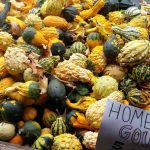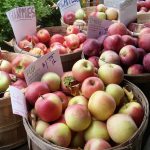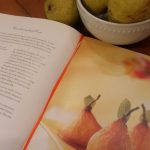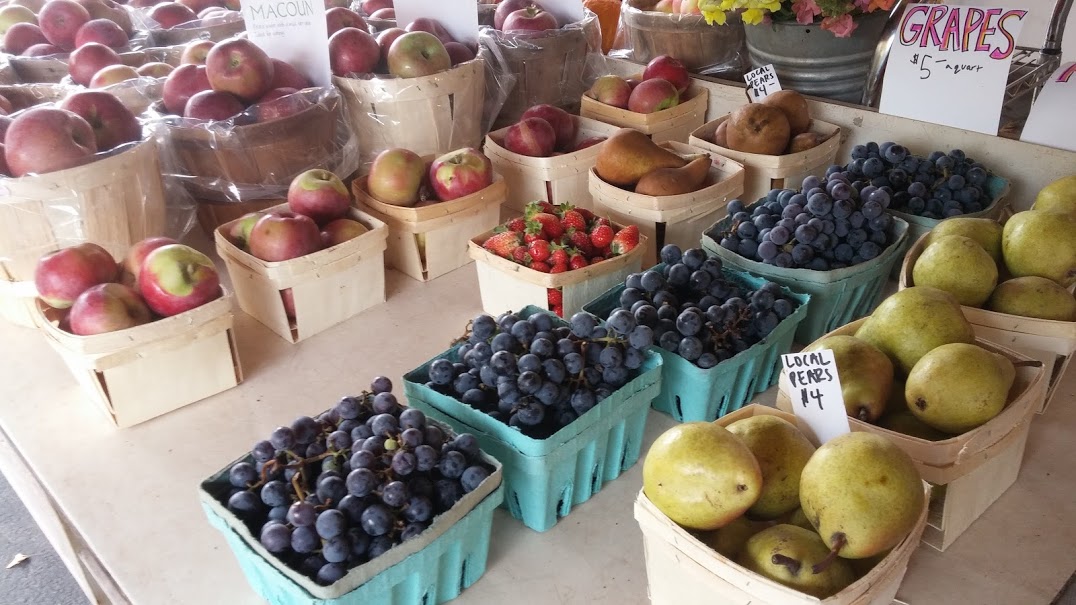Crisp air in the morning, a blush of color in the trees, shortened days – the seasons are changing. I can see it at the farmer’s markets too.
It’s the last hurrah for the summer vegetables: a box or two of tomatoes (each week could be the last), a small heap of corn, a basket of eggplant, and the always-present zucchini.
 But thankfully other crops are coming into their own. Half the table is covered with tree fruits: apples – both heirlooms and old favorites, pears, plums, and a few baskets of concord grapes. Orange pumpkins, ribbed squash, and striped gourds fill bins and make colorful stacks on the ground.
But thankfully other crops are coming into their own. Half the table is covered with tree fruits: apples – both heirlooms and old favorites, pears, plums, and a few baskets of concord grapes. Orange pumpkins, ribbed squash, and striped gourds fill bins and make colorful stacks on the ground.
It’s the pears that have my interest now. Cultivated across the civilized world since ancient times, pears have always been on our menu. But they lack the good PR of apples, having neither a central biblical role nor the purported health advantage of, “an apple a day…”
 Unlike reliable apples that are true to type and ready to eat, pears must be ripened. It’s a mysterious process with uncertain results. You can’t pick a perfect pear; they don’t ripen on the tree. Some time at room temperature is the only way to get juicy, flavorful fruit. I’m told that pears ripen from the inside out, adding to the mystery.
Unlike reliable apples that are true to type and ready to eat, pears must be ripened. It’s a mysterious process with uncertain results. You can’t pick a perfect pear; they don’t ripen on the tree. Some time at room temperature is the only way to get juicy, flavorful fruit. I’m told that pears ripen from the inside out, adding to the mystery.
Taken from the tree before their fragile peak, it’s never clear how much time will be needed to yield a faultless fruit. The conventional wisdom is to gently press at the narrow end below the stem. When it gives a little, the pear is ripe – a subjective test at best. At the farmer’s market where they know the source of the pears, they’ll often suggest a number of days to leave the pears out at room temperature.
But that’s not the whole story. Even after the pear morphs from hard to pliable, a sweet bite of juicy flavor is not assured. Sometimes they’re dry, sometimes mealy, sometimes bland, and sometimes perfect – maybe the best thing you’ve ever eaten. No matter how you slice it, pears are a gamble.
When you get a good one, it’s hard not to stand over the sink, taking bites and savoring the flavor while the juice runs down your chin. A perfectly ripe pear is a marvel, delicious by itself, great with salty blue cheese or sharp cheddar, famously paired with Stilton cheese by the English at Christmas time.
It’s hard to judge a pear by its cover. Bartletts and Anjous are picked with a light green skin. The Bartletts change to a pale greenish yellow as they ripen; the Anjous stay green. Neither sends a strong color signal saying, “I’m ready to eat.” Bosc pears, great for eating or cooking, are an unfortunate brown color with a rough skin that doesn’t change with ripening. Some varieties have a red blush, but this doesn’t signal ripeness either.
All that’s left is to give that gentle squeeze and then guess about ripeness. When they finally test ripe, eat them right away or keep them in the frig for a few more days.
Supermarket pears are even more of a mystery. I’ve had some that never ripen, just turn brown and get mushy. When they do ripen, the flavor and texture can be disappointing. A batch will ripen and be delicious just often enough to keep me on the hook, so I keep on trying.
Cooking pears is one way to avoid the search for perfect ripeness. Just before the pears are ready to eat, they’re ready to be used in your favorite recipe. Stay away from the softer Anjou pears – firmer Bosc and Bartlett varieties will stand up to cooking.
Poaching is one of the most popular ways to prepare pears. Peel them and poach with honey, cinnamon, vanilla, cloves, ginger or almost any other spice. Poaching in red wine is traditional and gives the pears a rich red color.
 Pears are great for tarts, galettes, and pancakes. Jacques Pepin in “Encore with Claudine” has a recipe for Roast Caramelized Pears that is easy and makes a great looking dessert. (FranksFeast.com for the recipe.)
Pears are great for tarts, galettes, and pancakes. Jacques Pepin in “Encore with Claudine” has a recipe for Roast Caramelized Pears that is easy and makes a great looking dessert. (FranksFeast.com for the recipe.)
If ripening is too tricky and cooking too much trouble, you can also drink our local pears. At Westford Hill Distillers in Ashford, CT Louis and Margaret Chatey make a classic Pear William eau de vie (clear brandy) from Connecticut grown fruit. I’ve been there when the tank of pears is fermenting – filing the distillery with the heady aroma of fresh pears. Made in small batches, the brandy has an enticing aroma and true pear flavor. Look for it at area stores including World of Beverage on Main Ave, Stew Leonard’s, and Ancona’s in Wilton.
Each fall I take up the quest of having a great pear experience. Like finding perfect peaches in the summer, the search can be challenging, but it’s definitely worth it!













No Comment